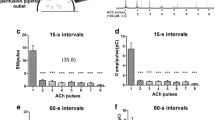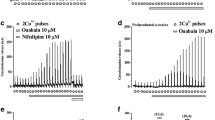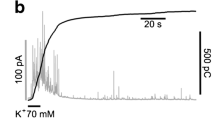Summary
We have previously shown that pertussis toxin (PTX) stimulates delayed-onset, [Ca2−] a -dependent catecholamine (CA) release from bovine chromaffin cells. We now show that this effect of PTX is inhibited in part (50%) by dihydropyridine Ca2−-channel antagonists niludipine and nifedipine, and is potentiated by the dihydropyridine Ca2+-channel agonist Bay K-8644. We and others have shown that pretreatment of chromaffin cells with PTX results in enhanced catecholamine secretion in response to high [K−] a , nicotine and muscarine, and here we extend these observations by showing that toxin pretreatment also enhances the secretory response to [Ba2+] a . All these data are consistent with the concept that PTX may act on Ca2− channels. To examine the possibility of a direct action of the toxin on the voltage-gated L-type Ca2+ channel known to be present in these cells, we studied the effects of the toxin on whole cell Ca2+ currents. We found and report here that spontaneous electrical activity was considerably increased in PTX-treated cells. Our measurements of whole cell inward Ca2+ currents indicate that the underlying mechanism is a marked shift of the activation curve of the L-type Ca2+ current along the voltage axis towards more negative potentials. While treatment of the cells with PTX had no effect on L-type Ca2+-channel conductance (6 nS/cell at 2.6mm [Ca2+] a ). PTX evoked the activation of a new class of Ca2+-selective channels (5 pS in 25mm [Ca2+]pipet), which are rather insensitive to membrane potential. We have termed theseG-type calcium channels. These data suggest that treatment with PTX not only increases the probability of L-type Ca2+-channel activation at more negative potentials, but also increases the probability of opening of an entirely new, voltage-independent, Ca2+ channel. These actions of PTX should promote Ca2+ entry and might explain the stimulation by the toxin of CA secretion from medullary chromaffin cells in culture.
Similar content being viewed by others
References
Bourne, H. R. 1988. Preliminary structural model of the G-protein alpha-chain.Adv. Second Messenger Phosphorylation Res.21:33–38
Brocklehurst, K., Pollard, H. B. 1988. Pertussis toxin stimulates delayed-onset, Ca-dependent catecholamine release and the ADP ribosylation of a 40 kDa protein in bovine chromaffin cells.FEBS Lett. 234:439–445
Brocklehurst, K.W., Morita, K., Pollard, H.B. 1985. Characterization of protein kinase C and its role in catecholamine secretion from bovine adrenal-medullary cells.Bichem. J. 228:35–42
Brown, A.M., Birnbaumer, L. 1988. Direct G-protein gating of channels.Am. J. Physiol. 254:H401-H410
Burgoyne, R., Morgan, A. 1989. Low molecular mass GTP-binding proteins of adrenal chromaffin cells are present on the secretory granule.FEBS Lett. 245:122–126
Ceña, V., Stutzin, A., Rojas, E. 1989. Effects of calcium and Bay K-8644 on calcium currents in adrenal medullary chromaffin cells.J. Membrane Biol. 112:255–265
Chad, J., Kalman, D., Armstrong, D. 1987. The role of cyclic AMP-dependent phosphorylation in the maintenance and modulation of voltage activated calcium channels.Soc. Gen. Physiol. Ser. 42:167–186
Cockcroft, S., Howell, T.W., Gomperts, B. 1987. Two G-proteins act in series to control stimulus-secretion coupling in mast cells, use of neomycin to distinguish between G-proteins controlling phosphoinositide phosphodiesterase and exocytosis.J. Cell Biol. 205:2745–2750
Forsberg, E.J., Pollard, H.B. 1988. Ba2+-induced ATP release from adrenal medullary chromaffin cells is mediated by Ba2+-entry through both voltage and receptor gated Ca2+ channels.Neuroscience 27:711–715
Goldman, D.E. 1943. Potential, impedance and rectification in membranes.J. Gen. Physiol. 27:37–60
Greenberg, A., Zinder, O. 1982. Catecholamine secretion from isolated adrenal medulla cells.Cell Tissue Res. 226:655–665
Gomperts, B.D., Barrowman, M.M., Cockcroft, S. 1986. Dual role for guanine nucleotides in stimulus-secretion coupling.Fed. Proc. 47(7:2156–2161
Heldman, E., Levine, M., Raveh, L., Pollard, H.B. 1989. Barium ions enter chromaffin cells via voltage-dependent calcium channels and induce secretion by a mechanism independent of calcium.J. Biol. Chem. 264(14:7914–7920
Hodgkin, A.L., Katz, B. 1949. The effect of sodium ion on the electrical activity of the giant axon of the squid.J. Physiol. 108:37–77
Neher, E., Almers, W. 1986. Patch pipettes used for loading small cells with fluorescent indicators.Adv. Exp. Med. Biol. 211:1–5
Pollard, H.B., Ornberg, R., Levine, M., Heldman, E., Morita, K., Kelner, K., Lelkes, P.I., Brocklehurst, K., Forsberg, E., Duong, L., Levine, R., Youdim, M.B.H. 1985. Hormone secretion by exocytosis with emphasis on information from the chromaffin cell system.Vitam. Horm. 42:109–196
Rojas, E., Hidalgo, J., Carroll, P., Li, M.X., Atwater, I. 1990. A new class of calcium channels activated by glucose in human pancreatic beta cells.FEBS Lett. 261:265–270
Rosenthal, W., Hescheler, L., Trautwein, W., Schultz, G. 1988. Receptors and G-protein mediated modulation of voltage-dependent calcium channel.FASEB J. 2:2784–2790
Sasakawa, N., Yamamoto, S., Nakaki, T., Kato, R. 1988. Effects of islet-activating protein on the catecholamine release, Ca2+ mobilization and inositol triphosphate formation in cultured adrenal chromaffin cells.Biochem. Pharmacol. 37:2485–2487
Sekura, R.D., Moss, J., Vaughan, M. 1985. Pertussis Toxin. Academic, Orlando, FL
Stutzin, A., Stojilkovic, S., Catt, K.J., Rojas, E. 1989. Characteristics of two types of calcium channels in rat pituitary gonadotrophs.Am. J. Physiol. 257:C865-C874
Tanaka, T., Yokohama, H., Negishi, M., Hayashi, H., Ito, S., Hayashi, O. 1987. Pertussis toxin facilitates secretagogue-induced release from cultured bovine adrenal chromaffin cells.Biochem. Biophys. Res. Commun. 144:907–914
Toutant, M., Aunis, D., Bockaert, J., Homburger, V., Rouot, B. 1987. Presence of three pertussis toxin substrates and G0 a immunoreactivity in both plasma and granule membranes of chromaffin cells.FEBS Lett. 215:339–344
Author information
Authors and Affiliations
Rights and permissions
About this article
Cite this article
Ceña, V., Brocklehurst, K.W., Pollard, H.B. et al. Pertussis toxin stimulation of catecholamine release from adrenal medullary chromaffin cells: Mechanism may be by direct activation of L-type and G-type calcium channels. J. Membrain Biol. 122, 23–31 (1991). https://doi.org/10.1007/BF01872736
Received:
Revised:
Issue Date:
DOI: https://doi.org/10.1007/BF01872736




